Canon EF-S 18-200 mm f/3.5-5.6 IS
3. Build quality and image stabilization
As we’ve already mentioned the aperture we must say something about a very unpleasant property of the tested lens. It starts with f/3.5 but, with the increase of the focal length, it becomes slower very quickly. Near 22 mm we get only f/4.0, at 35 mm – f/4.5 and near 50 mm – f/5.0. The f/5.6 aperture starts close to 85 mm.
The picture below shows the tested lens positioned next the EF-S 18-55 mm f/3.5-5.6 IS II and the EF-S 18-135 mm f/3.5-5.6 IS.
Please Support UsIf you enjoy our reviews and articles, and you want us to continue our work please, support our website by donating through PayPal. The funds are going to be used for paying our editorial team, renting servers, and equipping our testing studio; only that way we will be able to continue providing you interesting content for free. |
- - - - - - - - - - - - - - - - - - - - - - - - - - - - - - - - - - - - - - - - - - - - - - - -
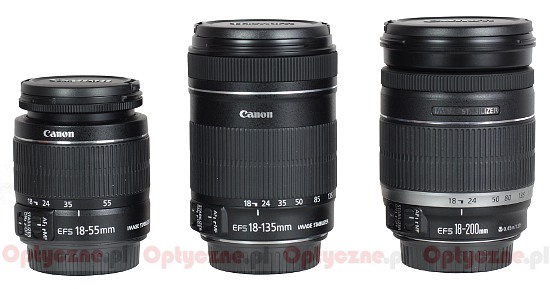 |
As you see in the kit lens class or their cheaper equivalents Canon remains very consistent – it offers stabilization but not an USM motor. It is rather strange because its rival devices boast such motors not only in the case of immediate competitors but in the cheaper segment as well.
The lens starts with a metal bayonet mount inside which you can find a plastic protrusion, characteristic for the EF-S versions; its main task is making impossible to attach the lens to a full frame reflex camera. Between the protrusion and the mount itself we also see some contacts and a part of a ring with the inscription: “CANON INC. MADE IN TAIWAN”.
The rear element is 24 mm in diameter and it hides about 0.5 cm deep inside the mount. When you pass to 200 mm the optical system shifts and the rear element can be hidden as deep as almost 4 cm, showing by the way the inside of the lens and several electronic pieces which were left on the top.
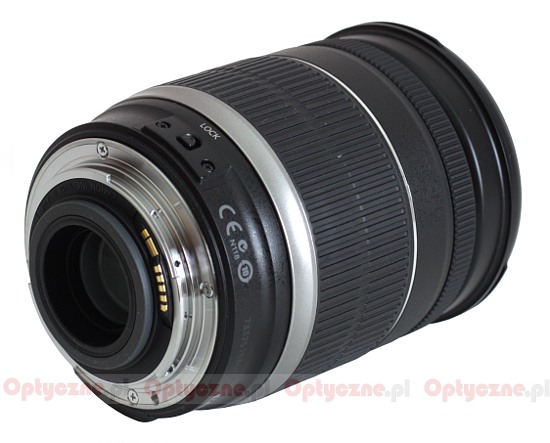 |
Moving to the proper housing we can find an inscription with parameters and, on the left, focusing mechanism mode switches (AF/MF) and the stabilization switch (STABILIZER ON/OFF). On the other side we have a LOCK switch which enables to lock the lens at 18 mm. We didn’t use it during our test even once, though, as you must shake the lens really vigorously to make the front element extend under its own weight.
The next part of the lens consists of a zoom ring as wide as 5.5 cm. It features a narrow strip with an inscription IMAGE STABILIZER, a silver ring, a ribbed part, 32 mm wide, and another silver ring with focal length markings at 18, 24, 50, 80, 135, 170 and 200 mm. The ring is comfortable to use but its work is hardly smooth – it moves with a greater resistance in the 24-135 mm range and in other ranges is noticeably easier to turn.
Then we see a manual focus ring which is ribbed and only 8 mm wide. In fact its small dimensions and the working range, which is just about 60-70 degrees, make any precise settings impossible.
The next part is the front elements system which, with the increase of the focal length, extends on a telescopic tube made of plastics. At the maximum focal length the lens is over 6 cm longer compared to the 18 mm setting. The front element, with a diameter of 58 mm, is surrounded by a non-rotating filter thread, 72 mm in diameter, and a mount used to attach a hood. The hood, unfortunately, must be bought separately – Canon has never spoiled its customers with rich accessory kits. The EF-S model is not an exception to that rule - the buyer can count only on caps.
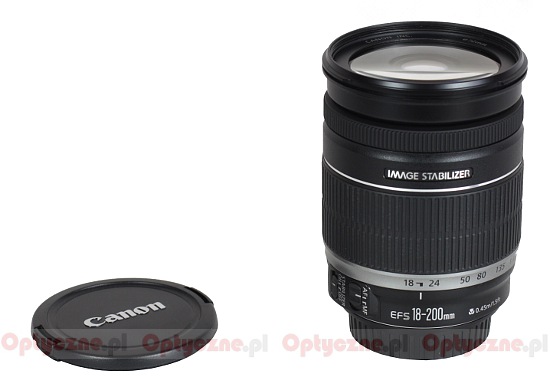 |
When it comes to optical construction we are dealing here with 16 elements set in 12 groups. The company boasts using two low-dispersion ED glass and two aspherical elements as well. Inside, you can also find a circular aperture with six diaphragm blades which can be closed down in the range from f/22 to f/36 depending on the focal length used.
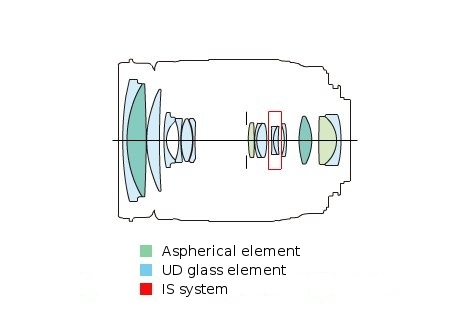 |
Image stabilization
The producer claims that the optical stabilization, used in the EF-S 18-200 mm model, is as efficient as 4 EV. We decided to check these claims. In order to do so we took several dozen of photos at 200 mm for every exposure time ranging from 1/320 t0 1/5 of a second with the stabilization on and off. The result in the form of a percentage of blurred photos is presented below (the 0 EV point is the equivalent of 1/200 of a second exposure time).
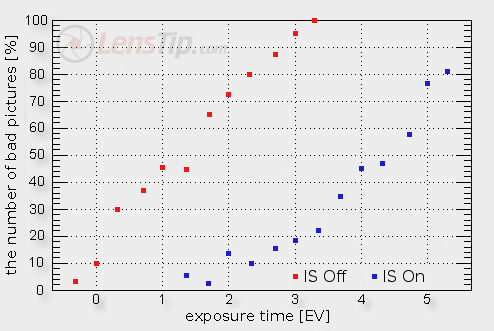
The maximum distance between these two curves reaches 3.3 EV and we assess the stabilization of the tested lens to be as efficient as that value. Although the result is below the promised 4 EV still it remains very good and definitely worth our praise.






